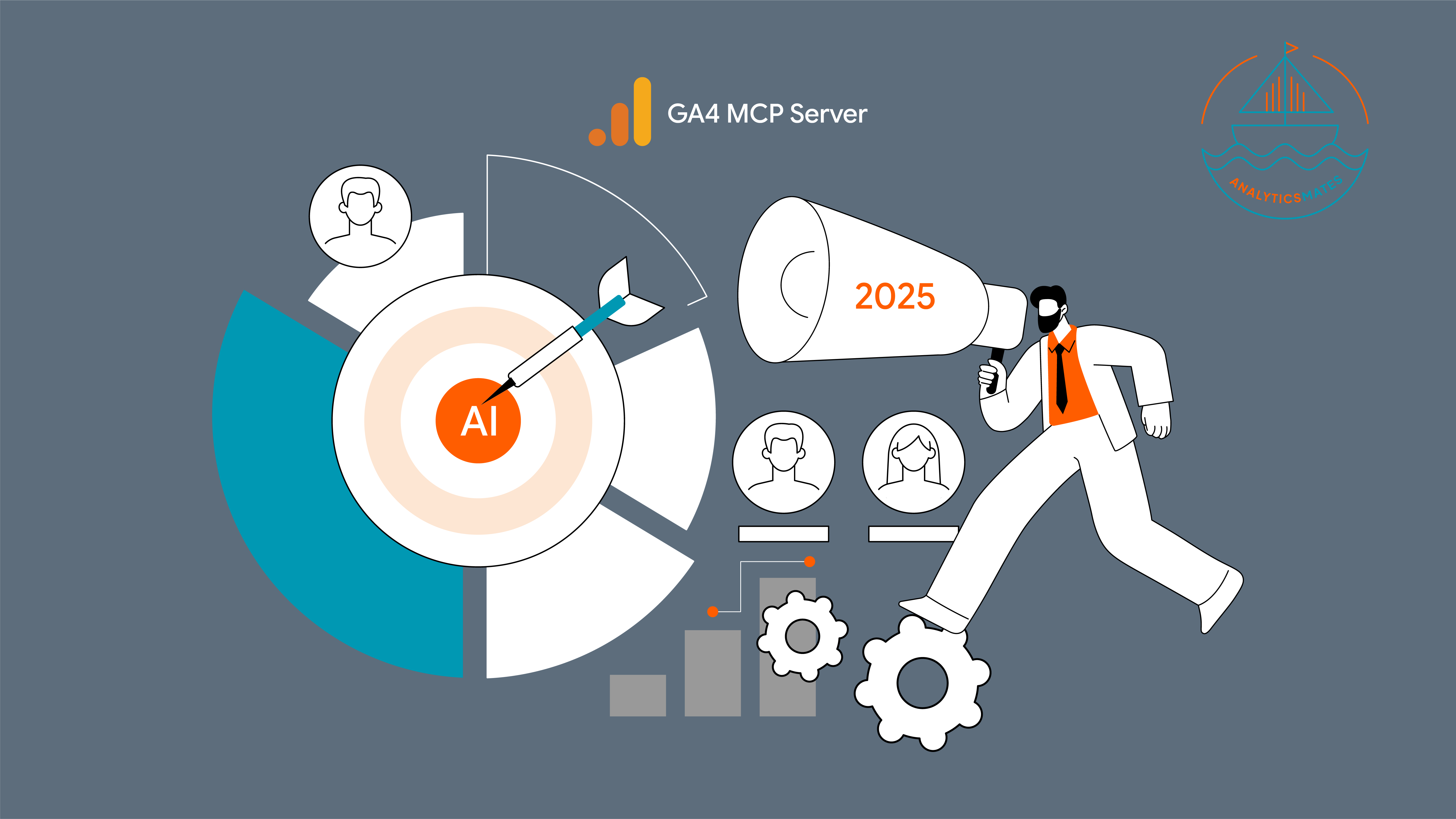Having gotten the hang of creating and navigating through GA4, we're not strangers to its landscape anymore. Yet, to ensure the data we rely on remains trustworthy, we must delve into its settings. These settings might be hidden away, but they hold the power to guarantee the accuracy of our insights. In this part of our GA4 journey, we'll uncover these settings, learning how they preserve the quality of our data collection. So, let's explore these configurations together and take our GA4 familiarity up a notch!
Update Data Retention to 14 Months
The Google Analytics Data Retention controls give you the ability to set the amount of time before user-level and event-level data stored by Google Analytics is automatically deleted from Analytics servers.
For Google Analytics 4 properties, you can set the retention period of user-level data to:
- 2 months
- 14 months
This retention period also applies to conversion data.
Here are the steps on how to update your Retention period:
- In Google Analytics, click Admin.
- Make sure you are in the correct account and property.
- For Google Analytics 4 properties: In the PROPERTY column, click Data Settings > Data Retention.
- For Google Analytics 4 properties: Event data retention: select the retention period you want.
- For Google Analytics 4 properties: Reset user data on new activity: turn the switch on or off.
- Click Save.
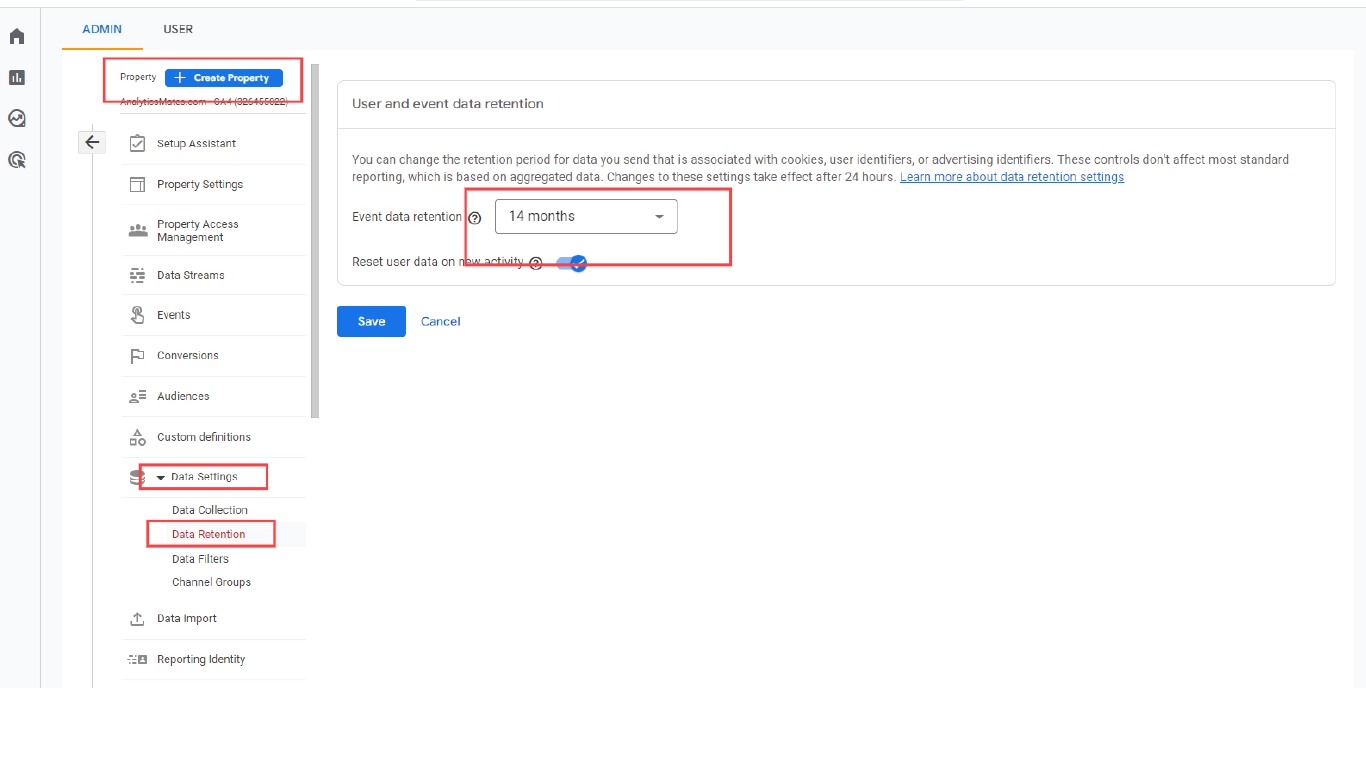
Things you should know about Data Retention:
- Reducing Retention Period: If you decrease the time data is kept, affected data is removed during the next monthly process. For instance, if you change from storing data for 14 months to only 2 months, any data older than 2 months gets deleted in the next monthly cycle.
- Increasing Retention for Google Analytics 4: Extending retention for a Google Analytics 4 property applies to existing un-deleted data.
- Retention Period Change Wait: When you modify the retention period, Analytics takes 24 hours to implement the change. Within this time, you can revert without affecting data.
- Date Range and Data Visibility: If you set a date range longer than your retention period for non-aggregated reports, the extra time's data isn't visible. For example, with a 14-month retention, a date range of 14 months + 1 day won't show data for that extra day.
Turn off Automated UA Events
Once this feature is enabled, GA4 will try to catch all events tracked by that analytics.js tracking code and you should see them in the Google Analytics 4 reports. However, there is an issue with this approach. Utilizing this functionality results in a loss of control and a shift of the UA technical burden to GA4. In short, if this is enabled you will persist in collecting UA events, that will lead to polluting your GA4.
You can disable this by following these steps:
- In Admin, click Data Streams in the Property column.
- Click Web and then click a web data stream.
- In the web stream details, click Configure tag settings (at the bottom).
- In the Settings section, click Show all to see all available options.
- Disable Collect Universal Analytics events.

Turn off Automated Form Submissions
GA4 frequently misinterprets user actions, causing unwarranted activation of form submit events, which in turn results in incorrect data. To address this problem, we highly suggest deactivating the pre-installed tracking for form interactions.
You can disable this by following these steps:
- In Google Analytics, click Admin.
- Make sure you are in the correct account and property.
- In the Property column, click Data Streams > Web.
- Under Enhanced measurement, slide the switch On to enable all options.
Click to edit individual options as needed.
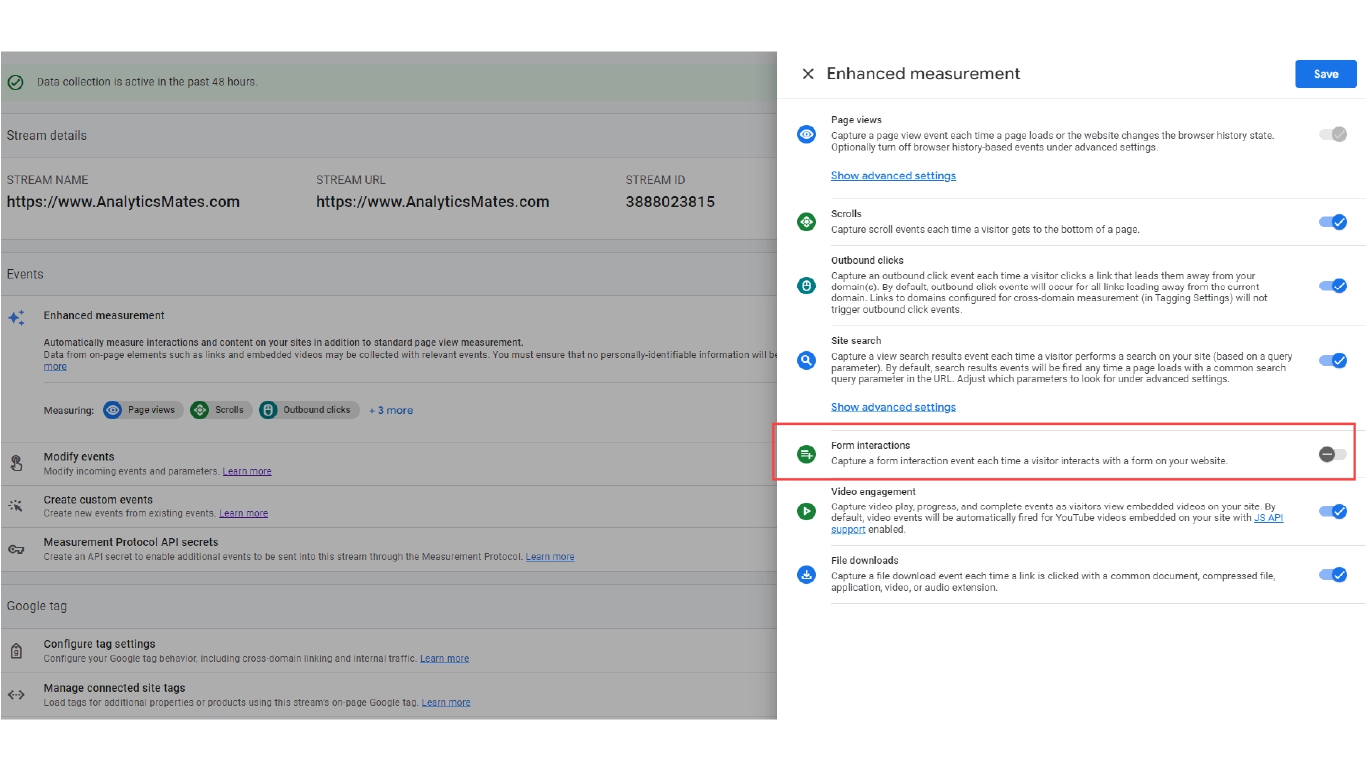
Turn on Automated Filters - Filter Internal Traffic
When incorporating Google Analytics 4, your own interactions and events are also monitored by default. This can pose a more significant issue when dealing with larger enterprises with a higher number of employees. Each visit or event initiated by an employee can distort your data. However, there is a solution to this problem, as you have the option to exclude internal traffic from being tracked in Google Analytics 4. Here are the steps:
By completing these steps, Analytics adds a traffic_type parameter to every incoming event. You can also manually add the parameter to your events.
1. In Google Analytics, click Admin.
2. Make sure you are in the correct account and property.
3. In the Property column, click Data Streams.
4. Click a web data stream.
5. In the web stream details, click Configure tag settings.
6. Click Show all.
7. Click Define internal traffic.
8. Click Create.
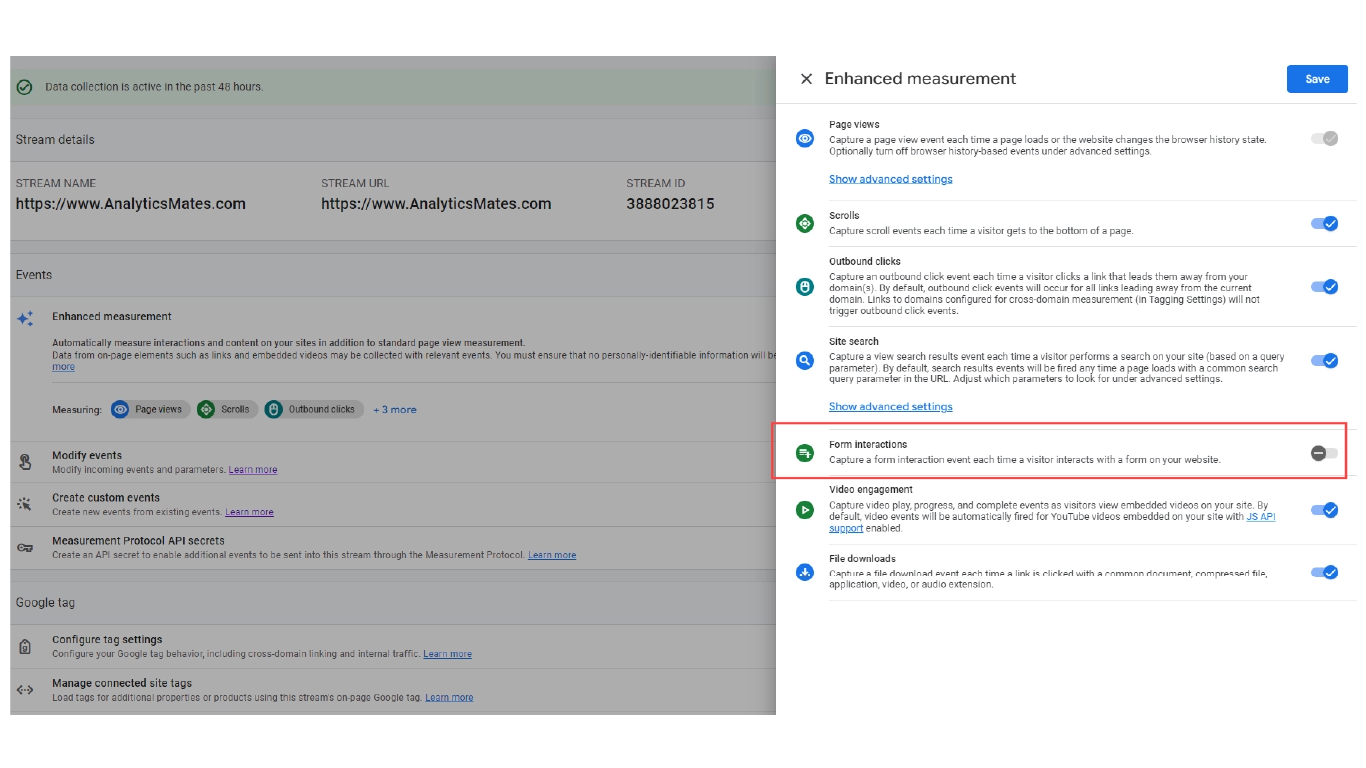
9. Enter a name for the rule.
10. Enter a value for the traffic_type parameter.
Note: traffic_type is the only event parameter for which you can define a value. internal is the default value, but you can enter a new value (e.g., emea_headquarters) to represent a location from which internal traffic originates.
11. In IP address > Match type, select an operator.
12. In IP address > Value, enter an address or range of addresses that identify traffic from the location you identified in Step 8. You can enter IPv4 or IPv6 addresses. You can also click "What's my IP address?" to find your public IP address. The Value field also supports the use of regular expressions (regex).
13. (Optional) Click Add condition to set multiple conditions. Any IP addresses that match the conditions will be marked as internal traffic. The conditions are OR conditions rather than AND conditions.
14. Click Create.
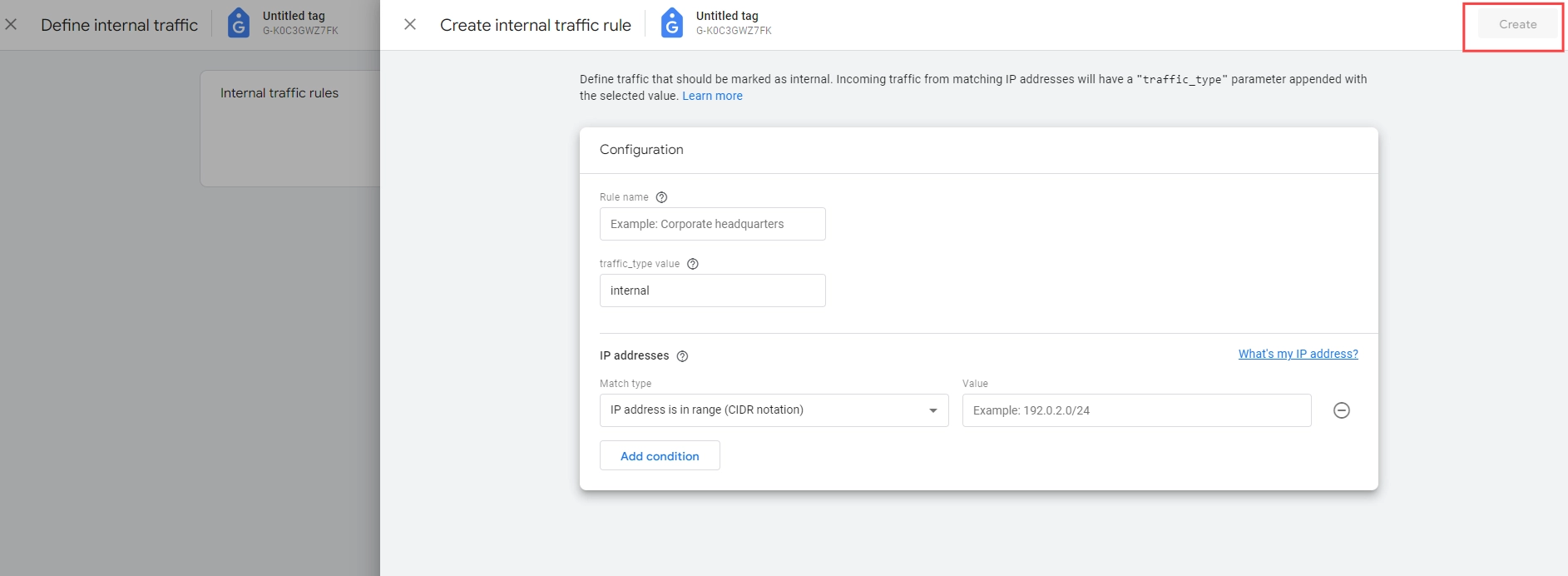
FAQs
Will updating data retention affect my data processing and reporting?
Answer: Updating data retention won't immediately impact data processing or reporting. However, you may notice changes in trends and insights as you start analyzing data over a more extended period.
Are there any privacy considerations when extending data retention?
Answer: Yes, it's crucial to ensure that you are compliant with relevant privacy regulations, such as GDPR. Extending data retention might impact user privacy, so it's recommended to review and update your data usage policies accordingly.
Can I turn off automated UA events retroactively?
Answer: While turning off automated UA events won't erase historical data, it will prevent further tracking of those events. Historical data will still be accessible in your GA4 reports.
Can I specify multiple IP addresses for the filter?
Answer: Yes, you can specify multiple IP addresses or IP ranges when setting up the filter. This is particularly useful if your organization has multiple office locations or a range of IP addresses that should be excluded from tracking.
What are the next steps
A clear grasp of the platform reduces our concerns about GA4. Let's keep discovering more about understanding data in GA4.
Here are some learning resources for you to continue the journey - GA4 Fundamentals - Diving Deeper into Event Conversions:
- Select Events as Conversions
- Create Events in GA4 as Conversion
- Create Event in Google Tag Manager as Conversion
Final Word
As we conclude this part of our GA4 journey, we've grown more familiar with its workings. We've learned that diving into its hidden settings is essential to ensure trustworthy data. These settings might be tucked away, but they play a big role in making sure our insights are accurate.
We've uncovered these settings together, discovering how they keep our data collection in top shape. Our GA4 expertise has leveled up, but our pursuit of reliable information continues.
By understanding and adjusting these settings, we're actively maintaining the quality of our analytics. As we move forward, let's keep exploring and refining our approach. Our journey has equipped us with valuable insights, and we're better prepared to use GA4 effectively.
So, let's keep our curiosity alive and our determination strong. The path ahead holds more to discover, and we're ready to make the most of GA4 for better insights. Here's to the next steps in our GA4 adventure!
We're always looking for ways to improve our Google Analytics 4 blog content. Please share your feedback so we can make it even better.
See Article Images










